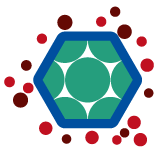Important core aspects of the participating subprojects are the changed wetting behaviour by melting due to oxide-free surfaces and/or the changed mechanisms leading to material closure. The latter is generated or considered between different states of aggregation: solid-solid, solid-liquid and liquid-liquid. With regard to the absence of passivations, considerably reduced to no interfacial gaps are expected in the boundary surface transitions. Similar to the surface quality, as it occurs in microstructures during polymorphic solidification, also in the processes with passivation-free material closure, shares of small and large angle grain boundaries, local lattice adjustments and/or intermetallic phase formation with partially coherent and incoherent phase transitions are to be expected, from which correspondingly high strengths should result.
The workgroup therefore supports the project partners in the selection and implementation of suitable analysis and investigation methods, leads the cross-project scientific discussion on the material science results and mechanisms of action and develops corresponding models for the physical-chemical interactions.


